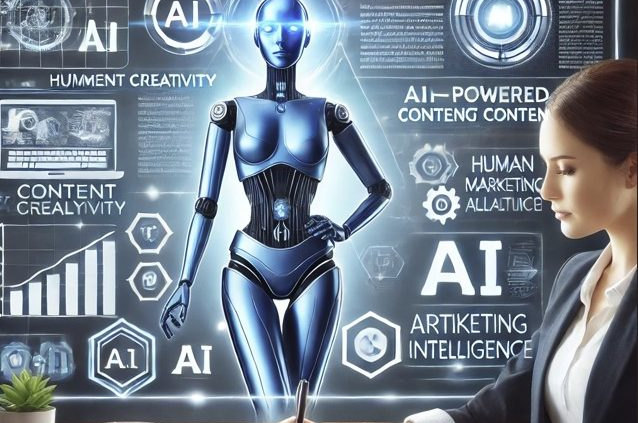The Role of AI in Content Creation: Will Machines Replace Marketers? – Times Square Chronicles
Published
on
By
AI-generated content is everywhere. From automated blog posts to AI-driven social media captions, businesses are increasingly relying on artificial intelligence to streamline content creation. But does this mean human marketers are becoming obsolete? Not quite. While AI is revolutionizing the way content is produced, it still lacks the creativity, emotional intelligence, and strategic thinking that human marketers bring to the table.
AI-powered tools like ChatGPT, Jasper, and Copy.ai can generate content in seconds, helping businesses create blog posts, ad copy, and even video scripts at an unprecedented speed. This efficiency saves time and reduces costs, making AI a valuable asset for businesses looking to scale their marketing efforts. However, AI-generated content is often formulaic; it can produce grammatically correct, well-structured content, but it struggles with originality, brand voice, and deep emotional storytelling.
One major limitation of AI is its lack of human insight and creativity. While AI can pull from massive datasets to identify trends and suggest content ideas, it doesn’t truly understand emotions, cultural nuances, or the subtleties that make great storytelling so powerful. The best marketing campaigns connect with people on a personal level, something AI, at least for now, struggles to do convincingly.
Another challenge is AI’s reliance on existing data. AI models don’t generate new ideas; they remix and repackage existing information. This can lead to repetitive content, lack of differentiation, and even unintentional plagiarism. Businesses that rely solely on AI for content risk blending in rather than standing out.
Despite these limitations, AI is a powerful tool when used correctly. Instead of replacing marketers, it acts as an assistant handling tedious tasks like content research, generating rough drafts, and optimizing headlines. Human marketers can then refine, edit, and add personality to AI-generated content, ensuring it aligns with their brand’s voice and marketing strategy.
The future of content creation isn’t about AI versus humans, it’s about collaboration. The businesses that succeed will be the ones that leverage AI for efficiency while still relying on human creativity for originality and emotional depth. AI is here to stay, but marketing will always need a human touch.
Want to see what Ai can do for your business? Schedule a call with the team at www.MyLocalDesign.com
How to Build an Email List That Actually Makes You Money
Microsoft’s New In-House AI Models: A Game Changer for Small Businesses
Cenk Demircan is an entrepreneur, author, and business strategist who thrives at the intersection of innovation and efficiency. As the founder of Elite Coaching Circle, he has guided countless entrepreneurs toward success, blending mindset, strategy, and execution. His latest venture, Fire Your Employees, challenges traditional business models by leveraging AI and automation to streamline operations and maximize growth. With a relentless drive for transformation, Cenk continues to push boundaries, helping businesses evolve in an ever-changing digital landscape.
The Personalization Paradox: When Your Brand Knows Too Much and Says It Out Loud
AI and the Creator Economy: Partner, Plagiarist, or Creative Frenemy?
Published
on
By
Amazon has just changed the game for logistics—again. With the launch of its 1 millionth robot and a new AI-powered system called DeepFleet, the tech and retail giant is not only setting new standards in automation but also reshaping customer expectations across every sector. For small business owners, this is more than industry news—it’s a wake-up call.
The company announced the deployment of its 1 millionth mobile robot across its 300+ global fulfillment centers, along with DeepFleet, a generative AI system designed to orchestrate robot traffic and reduce delivery times. The new AI model, built on Amazon’s vast internal logistics data and powered by Amazon Web Services, improves robotic travel time by 10%—a margin that translates into faster shipping, lower operational costs, and more efficient fulfillment.
Amazon’s AI Leap = Rising Expectations for Everyone Else
For consumers, this may mean getting their packages even faster.
But for small businesses—particularly those in e-commerce, logistics, and retail—the implications are far more serious.
> “Amazon’s new normal becomes the new bar. Faster delivery, cheaper logistics, and smarter systems are now what your customers will come to expect,” says Maya Richards, an AI consultant for SMB operations. “If you’re not integrating automation or AI in some form, you’re falling behind.”
How Small Businesses Can Respond
1. Automate the Repetitive
Amazon robots now handle everything from lifting inventory to transporting packages across giant warehouses. While most small businesses won’t be installing robots anytime soon, they can (and should) adopt digital “AI employees” to manage tasks like customer support, lead follow-up, appointment setting, and even inventory tracking.
2. Embrace Smart Logistics
From predictive inventory management to route optimization software, tools powered by AI are now accessible and affordable. Amazon’s use of DeepFleet shows how even a 10% gain in efficiency can massively impact bottom lines. For a small business, using AI for restocking predictions or shipping logistics could mean the difference between profit and loss.
3. Focus on Upskilling, Too
One surprising aspect of Amazon’s update is its commitment to training over 700,000 employees to work with robotics and advanced tech. This challenges the misconception that AI replaces people—when in fact, it’s creating new roles in operations, systems management, and technical maintenance. Small businesses should follow suit and invest in upskilling themselves or their teams.
The Hidden Threat: The “Invisible Advantage” of Big Tech
Amazon isn’t just using AI—it’s manufacturing its own robots in the U.S., creating a tight feedback loop between design, production, and real-world operations. This gives it a massive edge in speed, efficiency, and scalability.
Small businesses can’t replicate that infrastructure, but they can adopt off-the-shelf AI tools to enhance their agility. From AI chatbots and voice assistants to sales automation and review responders, there are plug-and-play solutions designed for SMBs at a fraction of the cost of hiring full-time.
Amazon’s latest announcement isn’t just about the future of fulfillment—it’s about the future of competition. Small businesses that embrace automation now, even in small ways, will be better positioned to survive and thrive as customer expectations shift in the age of AI.
If your business isn’t moving toward automation, just know: Amazon’s already a million steps ahead.
To help you figure out how book your ai growth strategy session here
Published
on
By
Amazon has always been the poster child for scale. Warehouses the size of small countries, servers running half the internet, and now AI doing the work that used to require an entire floor of Ivy League MBAs. CEO Andy Jassy recently gave the world a heads-up: Amazon is hiring fewer corporate employees because generative AI can do more of what they used to.
Translation? Your next brainstorm might happen without anyone actually using their brain.
It is not that Amazon is gutting its white-collar teams. But the hiring freeze speaks volumes. Generative AI tools can already write reports, analyze spreadsheets, prep customer insights, summarize meetings, and even optimize marketing strategies. For a company that thrives on speed and efficiency, automating knowledge work is a logical, if slightly chilling, next step.
The corporate jungle is watching closely. If Amazon can run with fewer analysts, fewer marketers, fewer junior execs, what stops other firms from following suit? AI tools are no longer just assistants they are becoming teammates. The kind that show up early, do not ask for raises, and always finish their decks on time.
This shift is not just about cutting costs. It is about rethinking what corporate value actually means. If a tool can process data faster than a person and draft a strategy outline in minutes, where do human employees add the most value? Creativity, empathy, long-term thinking sure. But that narrows the talent pool and reshuffles the org chart.
And let’s not ignore the emotional undercurrent. Telling your workforce that AI will replace some roles but not others creates anxiety, not inspiration. It forces companies to double down on communication, reskilling, and a brutally honest look at what jobs are actually safe.
For Amazon, the move is a strategic bet. For corporate America, it is a wake-up call. Generative AI is no longer experimental. It is operational. It is scaling. And if your job involves organizing knowledge, connecting ideas, or summarizing findings you might want to upskill before your algorithm outpaces you.
Published
on
By
The U.S. government is going all-in on artificial intelligence, and while the headlines are about defense and federal contracts, there’s a deeper signal small businesses can’t afford to miss: AI is no longer optional—it’s the future of operations, decision-making, and survival.
On June 30, tech giants Palantir and Accenture Federal Services announced a major partnership to modernize federal government systems using AI. The goal? Automate decision-making, streamline supply chains, improve budget transparency, and deliver data from the top all the way to the battlefield.
And here’s the kicker: if the federal government—known for its red tape and resistance to change—is overhauling its operations with AI, it’s only a matter of time before every serious business, big or small, is expected to do the same.
Why Small Businesses Should Care
You might not be managing military supply chains or federal budgets, but the problems this partnership is solving are the same ones small businesses face every day:
This collaboration sets a precedent: AI is now the standard for operational excellence. If you’re still using spreadsheets and sticky notes, you’re going to be left behind.
From Boardrooms to Backrooms: AI Is Going Mainstream
Palantir’s tech will be used to push real-time data to the “edge” of operations—that means the frontlines, whether it’s the battlefield or your sales floor. Accenture is training 1,000 data professionals just to support this AI rollout for the government.
That kind of scale signals that AI solutions are maturing rapidly, and the commercial versions are already being adopted by private companies to:
The Opportunity for Small Businesses
While federal agencies spend millions, AI has become accessible to even the smallest business owner—thanks to low-cost, high-impact AI assistants, voice responders, chatbots, and automation platforms tailored to small business needs.
Here’s how forward-thinking small businesses are already using AI:
A dentist’s office that uses AI to follow up with missed calls and schedule appointments automatically.
A construction company that gets AI-generated bids, estimates, and proposal follow-ups sent while the crew is still on the job.
A local gym that uses AI to engage members, send reminders, and reduce
If AI Can Run a War Room, It Can Run Your Business
This isn’t about hype—it’s about survival. The same AI powering government transformation is trickling into the private sector at warp speed.
If you want to stay competitive, now’s the time to evaluate how AI can streamline your operations, boost your efficiency, and grow your revenue—without growing your payroll.
What You Can Do Today
Audit your processes: What’s repetitive, manual, or time-consuming?
Talk to an expert: AI consultants are now offering free strategy sessions.
Start small: A chatbot, an AI voice assistant, or an automation flow can deliver ROI in days.
As the government embraces AI to run smarter, faster, and leaner—the real question for small businesses isn’t “if” they should follow, but “how fast.”
If you need help getting started book your ai strategy growth session here.
Published
on
By
The search engine landscape is ever-evolving. However, that does not mean backlinks have become irrelevant. For every stakeholder in the SEO arena, one strategy remains a subject of debate: buying high quality backlinks in the USA. Some SEO experts advocate for strategic link buying from credible sources. But some others caution against the potential risks.
Backlinks are an important tool in SEO. They help you get a better trustworthiness for your site. It is essential that these backlinks originate from reputable and authoritative websites
Strive to get more quality backlinks to your page. Your website will gain more credibility as a result of this. But not every backlink is equal. It is enough to get a single high-quality backlink. It will work better than hundreds of low-quality, spammy links.
Buying backlinks comes with several benefits. It can help you save enough time that would otherwise be spent on outreach and succeeding in getting your backlinks naturally. With this, you can control your backlink profile better.
Are you in a competitive niche? We recommend buying backlinks to improve your performance. These niches include law, real estate, or e-commerce. Create a strong backlink profile. This will make sure that you do not fall behind in the face of competition.
Well, the opinions of the experts vary. Like an expert in the USA, “Google’s algorithm rewards authority and trust. Getting backlinks is still essential, but the source and quality of the link matter more than ever.” Buying backlinks is not wrong. But, make sure to get them from high authority websites.
Experts are also of the opinion that buying backlinks should be undertaken with due care. They state that “purchased backlinks can be helpful, but they should not be manipulative in nature.”.
Another expert believes that it is safe to buy backlinks. However, you should learn to understand the difference between editorially placed links and manipulative links. He recommends going through the recent news and updates from search engines and vetting your sources wisely.
John Mueller from Google clearly states that buying backlinks only for ranking is against the guidelines from Google. You should focus on the content and relationships. That should mean Google does not mind if you buy backlinks, but they should be related to your industry or niche. Moreover, your content should also be of high quality.
So, you are looking to invest in backlinks in the USA? There are a few tips that can be helpful.
Yes, it is worth buying backlinks. But you should do it with caution. Buying backlinks is the best way to improve your SEO. However, make sure that you have partnered with the trusted providers. Providers like Perfect Link Building offer you an excellent array of services for buying high quality backlinks in the USA.
When integrated with a strong content marketing strategy, ethical link buying is not only worth it, but it can be a game-changer for brands looking to scale quickly and sustainably.
Published
on
By
Meta is making headlines again—not for a new social media feature, but for its aggressive push into artificial intelligence. With reports of $100 million bonuses to lure top AI talent, Mark Zuckerberg’s tech giant is betting big on generative AI, automation, and so-called “superintelligence.” But the real question is: what does this mean for small businesses?
Big Moves from Big Tech
In recent weeks, Meta has invested over $14 billion to acquire a 49% stake in Scale AI, a company that specializes in labeling data for training AI models. It’s also recruiting top engineers from competitors like OpenAI and Google-backed Perplexity AI.
Zuckerberg is reportedly concerned that Meta is falling behind in the generative AI race—where AI writes code, creates content, and handles complex customer interactions. To close that gap, he’s forming a “superintelligence” division with some of the brightest minds in the space.
While some tech analysts question whether this mercenary-style talent acquisition will pay off, others see Meta’s long-term vision: a fully AI-driven advertising and operations platform that could eventually cut out ad agencies and even human creative teams.
The Small Business Perspective: Opportunity or Threat?
For small businesses, these tech industry power plays may seem distant. But they have direct implications:
Lower Costs, Fewer Gatekeepers: Meta’s vision includes AI systems that help brands create ads, target customers, and optimize campaigns—without needing a marketing team. For small businesses, this could mean lower costs and faster execution.
AI as a Competitive Equalizer: As Meta and others build user-friendly AI tools, small businesses could get access to the same kinds of capabilities as Fortune 500 firms—personalized marketing, 24/7 customer support, and data analysis done in seconds.
Disruption of Traditional Services: On the flip side, agencies, freelancers, and creative firms that support small businesses could find themselves squeezed out by AI-powered platforms. If Meta delivers on its promise of a “turnkey ad solution,” small businesses might become more reliant on tech platforms—and less on human service providers.
Don’t Wait—Adapt Now
Experts say companies don’t need the most powerful AI model to win. What matters is how well that AI is applied in specific business scenarios. Mehmet Canayaz of Penn State notes that even companies without the top tech—like Meta’s underperforming Llama model—can still thrive with purpose-built AI solutions.
That’s a message small businesses should take to heart: you don’t need a $100 million engineer to start using AI. But you do need to start thinking about how to integrate it into your operations now—before your competitors do.
Ultimately, Meta’s spending spree may be about claiming dominance in AI, but the ripple effect is already reaching Main Street. As tools become more powerful and accessible, small businesses have a window of opportunity to adopt AI early—streamlining their operations, improving customer experience, and driving growth.
Whether it’s automating lead follow-up, using chatbots for support, or launching ad campaigns without an agency, the future is clear: the AI revolution isn’t just coming—it’s already here. Get up to speed
Simple 4th of July Treats
Meta’s $100 Million AI Spree: What It Means for Small Businesses
Hamptons Social Magazine Cover Party Lights Up Montauk and Wonder Shuffle at Marina St Barts Boutique
Breakin’ NYC: A Celebration of Hip-Hop’s Heartbeat at Theatre 555
Prince Mario-Max Schaumburg-Lippe announced as Royal Presenter of Hamptons Fashion Week
Dilaria at DR2: A 90-Minute Ego Trip to Nowhere
July in NYC: Summer Pulse and City Rhythms
The Glorious Corner
Copyright © 2023 Times Square Chronicles






